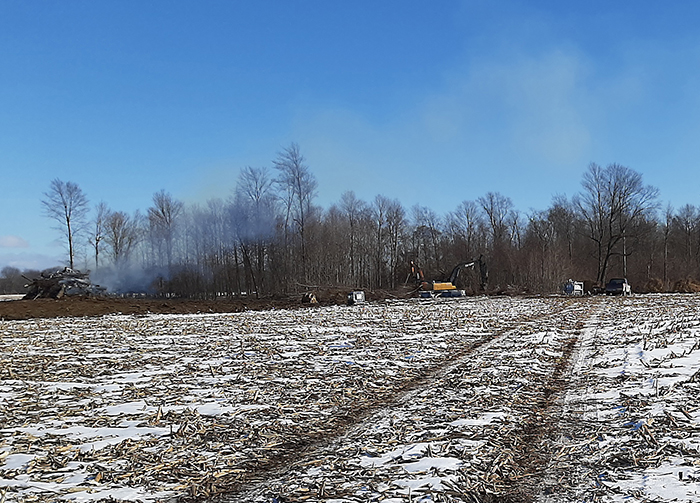
By Jenna Cocullo, Local Journalism Initiative
Chatham-Kent’s tree conservationists are sounding the alarms after private property owners in East Kent chose to cut down a woodlot, which may contain at-risk species.
On Wednesday, cars drove Spence Line by Orford Road, North of Highway 401, and honked in protest as private landowners started clearing an area that could be covered by American Chestnut trees.
The issue with the conservationists is not so much what the property owners are doing but rather frustration with the Municipality of Chatham-Kent for not doing more to protect significant woodland.
“The city has an obligation to identify and protect significant woodlands, and it hasn’t done so. It doesn’t matter where (the woodlands) are,” said Ken Bell, a member of the Great Lakes Community Eco Initiative.
Bell said this woodland on private property is particularly important because it has been identified as a habitat for American Chestnut, which according to the Ministry of Natural Resources and Forestry is endangered.
The private property owners are within their rights to cut down the trees, and no permit was needed from the municipality of Chatham-Kent for the work. The Chatham Voice reached out to the landowners via telephone and they declined to comment on the situation.
In Ontario, American Chestnut is only found in the Carolinian Zone between Lake Erie and Lake Huron. Maps from the ministry show that there is a concentration of the tree in East Kent. Bell said there is no way of knowing if American Chestnuts are on that particular grid.
“There’s no way to know without actually going on the property. That’s a dilemma with a lot of these (private) properties,” he said.
“Chatham-Kent needs to have something to protect those woodlands, not to replace them, but to protect them, which Chatham-Kent has not done and they keep looking for different excuses not to do that.”
Bell recently launched an online petition requesting that council and administration rezone all significant woodlands over two hectares to an Open Space, from Agricultural Use, designation for the purpose of conservation.
In 2012, Chatham-Kent council decided not to implement a tree-cutting bylaw but rather chose to adopt a National Heritage Strategy to encourage education and tree planting initiatives. Essex and Chatham-Kent are the only two jurisdictions in Ontario without a forest bylaw enforcement officer, according to Randall Van Wagner, manager of Conservation Lands and Services with the Lower Thames Valley Conservation Authority (LTVCA).
Bruce McAllister, general manager of community development for Chatham-Kent, said that the municipality is working on a number of projects to address tree coverage issues, one being a change analysis using the latest photography with the LTVCA to assess how the strategy is working. A report is expected to come back in the spring.
“While zoning does potentially provide some protection, it certainly does not in itself prohibit somebody from destroying trees,” McAllister said.
Under an Open Space designation, residents will have to request permission from council to rezone to agricultural use, which could get denied, McAllister explained. However, even if that request were denied, there would be nothing stopping landowners from cutting down their trees anyway.
“I think that zoning changes are another tool in the toolbox, but I think we need to continue on with the work that we’re doing,” McAllister said. “I generally believe it’s good practice to eventually zone all our significant woodlands, but that should go through a comprehensive process and when we do our official update.”
Andrea O’Rourke, a founding member of CK Woodlot Preservation, said members of the group believe there needs to be a Chatham-Kent solution to accommodate farmers.
“We’re ag driven and we’re proud of it. But they got to come up with something that also compensates farmers,” she said.
One idea she’s suggested to the municipality is to provide compensation to farmers through tax reductions for every acre of woodlot preserved.
“If it’s for the common good then the common taxpayer may have to pay an extra $10 a year because we’re taking taxes off woodlots. That’s one of the ideas that we keep kicking around that a lot of farmers tell us,” she said, noting that 25 per cent of their group is made up farmers and the vast majority are rural residents.
Currently there is reforestation going on in areas of Chatham-Kent, however, Van Wagner said reforestation efforts won’t be enough to hold the line for tree coverage without the help of private property owners to gain more coverage.
“Most land in Ontario is owned by private landowners especially in Southern Ontario. Farmland, farmers and landowners are our main customers so we definitely need those properties if we are going to improve our percentage of forest cover,” he said.






